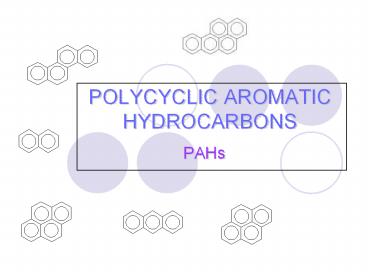POLYCYCLIC AROMATIC HYDROCARBONS - PowerPoint PPT Presentation
1 / 15
Title:
POLYCYCLIC AROMATIC HYDROCARBONS
Description:
Title: POLYCYCLIC AROMATIC HYDROCARBONS Author: mladkova Last modified by: bucherova Created Date: 2/23/2005 12:53:02 PM Document presentation format – PowerPoint PPT presentation
Number of Views:233
Avg rating:3.0/5.0
Title: POLYCYCLIC AROMATIC HYDROCARBONS
1
POLYCYCLIC AROMATIC HYDROCARBONS
- PAHs
2
What are PAHs?
- group of organic compounds
- two or more aromatic (benzene) rings are fused
together
3
- potential health risk due to their inner chemical
stability, high reactivity to different types of
degradation and high toxicity to living organisms - US EPA and in the European Union priority lists
of pollutants
4
Physical chemical properties
- Physical and chemical properties of PAHs vary
with Mr. - PAHs as pure chemicals exist as colorless, white,
or pale yellow-green solids. - They are non-polar, hydrophobic compounds, which
do not ionize. - They have a faint odor.
5
Enter the enviroment
- PAHs are introduced into the environment mainly
via natural and anthropogenic burning processes.
6
Enter the enviroment - Air
- PAHs enter air as releases from volcanoes,
forest fires, residental wood burning and
exhausts from cars. - Some PAH particles can readily evaporate into
the air from soil or surface waters.
7
Enter the enviroment - Water
- They can also enter surface water through
discharges from industrial plants and wastewater
treatment plants.
8
Enter the enviroment - Soil
- Most PAHs dont dissolve easily in water.
- They stick to solid particles and settle to the
bottoms of lakes or rivers. - PAHs in soils also contaminate underground water.
9
How might I be exposed to PAHs?
- We are most likely to be exposed to PAH vapors
or PAHs that are attached to dust and other
particles in the air. - Sources include cigarette smoke, vehicle,
exhausts, asphalt roads, coal, etc.
10
How likely are (PAHs) to cause cancer?
- Breathing or touching mixtures of PAHs and other
chemicals for long periods of time have developed
cancer. - Some PAHs have caused cancer in laboratory
animals when they breathed air containing them
(lung cancer), ingested them in food (stomach
cancer), or had them applied to their skin (skin
cancer).
11
Medical tests show PAHs in the body
- In the body, PAHs are changed into chemicals that
can attach to substances within the body. - Special tests that can detect PAHs in body
tissues or blood. - The tests aren't usually available in your
doctor's office.
12
Analytical determination of PAHs
- Samples of PAHs are mostly analysed by HPLC
using fluorence detection, or by gas
chromatography method with flame ionizazion
detection, or mass spectrometry.
13
More information
- For more information you can visit this pages
- http//www.atsdr.cdc.gov/toxprofiles/tp69.pdf
- http//wlapwww.gov.bc.ca/wat/wq/BCguidelines/pahs/
- http//www.inchem.org/documents/ehc/ehc/ehc202.htm
14
Vocabulary
- fuse - splynout
- lists of pollutants seznam
- škodlivin
- pale - bledý
- to vary - lišit se
- faint - mdlý
- to release - uvolnovat
- exhaust - výfukový plyn
- evaporate - vyparovat se
- discharge - vylucování
- wastewater treatment plant -
- cisticka odp. vod
- wastewater treatment plant - cisticka odp. vod
- to stick - prilnout
- to settle - usadit se
- vapor - pára
- to develope - rozvinout se
- ingested - prijímat potravou
- to be available - být k dispozici
- to attach - pripojit
- within - uvnitr
- body tissues - telní tkáne
15
- THANKS FOR YOUR ATTENTION































